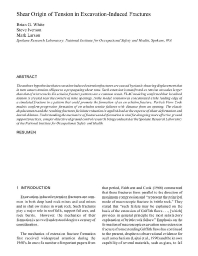 |
The authors hypothesize that excavation-induced extension fractures are caused by elastic shearing displacement that in turn causes tension oblique to a propagating shear zone. Such extension is manifested as tension on scales larger than that of microcracks. En echelon fracture patterns are a common result. FLAC modeling confirmed that localized tension is created near the corners of mine openings. In the model, tension was concentrated at the leading edge of a simulated fracture in a pattern that could promote the formation of an en echelon fracture. Particle Flow Code models confirm progressive formation of en echelon tensile failures with distance from an opening. The elastic displacements and the resulting fractures facilitate reduction in applied load at the expense of shear deformation and lateral dilation. Understanding the mechanics of fracture and deformation is vital for designing more effective ground support practices, a major objective of ground control research being conducted at the Spokane Research Laboratory of the National Institute for Occupational Safety and Health.
| Author(s): | White-BG, Iverson-SR, Larson-MK |
| Reference: | Culligan PJ, Einstein HH, Whittle AJ, eds. Soil and Rock America 2003. 12th Panamerican Conference on Soil Mechanics and Geotechnical Engineering and the 39th U.S. Rock Mechanics Symposium, Vol. 1. Cambridge, MA: Massachusetts Institute of Technology, 2003 Jun; 1:909-916 |
sooti (PDF, 396 KB)